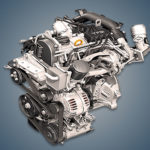The 1.4-liter Volkswagen CZCA 1.4 TSI engine has been produced in Mladá Boleslav since 2013 and is installed on many well-known models of the German concern, such as Golf, Passat, Polo Sedan. This unit is widespread, but in Europe it has long given way to 1.5 TSI engines.
The EA211 series includes: CWVA, CWVB, CJZA, CJZB, CHPA, CMBA, CXSA, CZCA, CZDA, CZEA, DJKA, DACA, DADA.
Specifications
| Production years | since 2013 |
| Displacement, cc | 1395 |
| Fuel system | direct injection |
| Power output, hp | 125 |
| Torque output, Nm | 200 |
| Cylinder block | aluminum R4 |
| Block head | aluminum 16v |
| Cylinder bore, mm | 74.5 |
| Piston stroke, mm | 80 |
| Compression ratio | 10.0 |
| Features | DOHC |
| Hydraulic lifters | yes |
| Timing drive | belt |
| Phase regulator | on the intake shaft |
| Turbocharging | TD025 M2 |
| Recommended engine oil | 5W-30 |
| Engine oil capacity, liter | 3.8 |
| Fuel type | petrol |
| Euro standards | EURO 6 |
| Fuel consumption, L/100 km (for VW Polo Sedan 2017) — city — highway — combined |
7.5 4.7 5.7 |
| Engine lifespan, km | ~275 000 |
| Weight, kg | 106 |
The engine was installed on:
- Audi A1 1 (8X) in 2014 – 2018;
- Audi A3 3 (8V) in 2013 – 2016;
- Seat Leon 3 (5F) in 2014 – 2018;
- Seat Toledo 4 (KG) in 2015 – 2018;
- Skoda Fabia 3 (NJ) in 2017 – 2018;
- Skoda Kodiaq 1 (NS) since 2016;
- Skoda Octavia 3 (5E) since 2015;
- Skoda Rapid 1 (NH) in 2015 – 2020; Rapid 2 (NK) since 2019;
- Skoda Superb 3 (3V) in 2015 – 2018;
- Skoda Yeti 1 (5L) in 2015 – 2017;
- Volkswagen Golf 7 (5G) in 2014 – 2018;
- Volkswagen Golf Sportsvan 1 (AM) in 2014 – 2017;
- Volkswagen Jetta 6 (1B) in 2015 – 2019;
- Volkswagen Polo Sedan 1 (6C) in 2015 – 2020;
- Volkswagen Polo Liftback 1 (CK) since 2020;
- Volkswagen Passat B8 (3G) in 2014 – 2018;
- Volkswagen Scirocco 3 (137) in 2014 – 2017;
- Volkswagen Tiguan 2 (AD) since 2016.
Disadvantages of the VW CZCA engine
- Most often, car owners with this power unit complain about the oil burner;
- Next in popularity is jammed turbine wastegate actuator rod;
- A plastic pump with two thermostats often leaks, but only changes entirely;
- According to the regulations, the timing belt is checked every 60,000 km, if it breaks, the valves bend;
- Also on the specialized forums there are a lot of complaints about extraneous sounds in the operation of the power unit.






